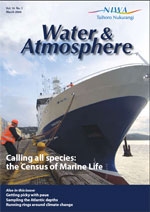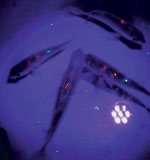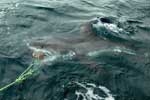PDF of this article (84 KB)



Dancing in the dark: VIE tags and ASUs
We know that biogenic (living) habitats such as seagrass meadows and horse mussel beds are important nurseries for juvenile fish of some species. Unfortunately, these habitats are also very vulnerable to human impacts, such as increasing sedimentation and turbidity from land-based activities. To measure the consequences of habitat loss and fragmentation for fish production, we have turned to artificial habitats as experimental tools. Using physical models, we can construct different habitat ‘landscapes’ and measure their relative ‘value’ to fish.
Initial trials last summer showed that artificial seagrass units (ASUs) work very well in New Zealand. We sampled almost 1000 fish from a combined habitat area of 5.5 m2.
Now two University of Auckland students are running similar experiments with other artificial habitats. In Mahurangi Harbour, Natalie Usmar is using resin moulds of horse mussels as a model habitat, and Ian McLeod will be transplanting patches of greenlipped mussels in the Firth of Thames. Their findings will help broaden our understanding of the ecological and fisheries values of complex biogenic habitats in coastal ecosystems.
We also need to be able to track the movements of different batches of fish in the field within and between different habitat patches. Last summer we ran tank-based trials of VIE (visible implant elastomer) tags. These tags, which are implanted in the fish, fluoresce in various colours when exposed to a blue light. Our trials determined that juvenile snapper (20–80 mm long)showed no negative effects from the tags over a 10-week period and the tags remaining intact throughout the experiment.
Now that we know ASUs and VIE tags will work, this summer we have placed several different ASU ‘landscape’ configurations in the Mahurangi Estuary and will be tagging a selection of juvenile fish in the area. We'll leave these landscapes for several months, and then measure their effects on juvenile fish production (for example on growth, survival, and movement). We'll use the results from these experiments in models that simulate habitat loss and fragmentation. Our aim is to be able to advise coastal resource managers on the likely consequences of different habitat management regimes to fish populations, including those supporting important coastal fisheries.
This research is supported by FRST as part of the Coasts and Oceans programme.
For further information, contact: Dr Mark Morrison, 0-9-375 2063, [email protected]
Further reading Morrison, M.; Lowe, M.; Spong, K.; Rush, N. (2007). Comparing seagrass meadows across New Zealand. Water & Atmosphere 15(1):16–17.
Matt Smith dives into his work. Water & Atmosphere 15(1): 27.
Sharks on the move
A great white shark has set a new distance record for a New Zealand shark by swimming more than 3000 km to the tropical waters of Australia’s Great Barrier Reef. The shark, nicknamed Kerri and measuring 4.4 m, has provided the first evidence that New Zealand great whites travel to Australia.
A New Zealand–US team of scientists tagged Kerri with an electronic ‘popup’ tag at Stewart Island in March last year. The tag records location, depth and temperature, and releases itself after a pre-determined time to transmit its data via satellite.
The tag began calling home on 18 December, making a welcome Christmas present for the scientists who had been waiting nine months to hear from Kerri. Her tag popped up south of the Swain Reefs off Rockhampton, an area known to have been visited by white sharks tagged in southern Australian waters. “Data since retrieved from the tag show that Kerri hung around Stewart Island for about four months before making some forays west,” says NIWA fisheries scientist Malcolm Francis. “She then took six weeks to get to Australia, diving as deep as 1000 metres along the way.”
Movements of a male shark tagged at the same time remain more mysterious, as his tag only transmitted intermittently. Three other sharks tagged off the Chatham Islands in 2005 revealed deep dives on long migrations to warm waters north of New Zealand. One went to New Caledonia, one to Vanuatu and thethird to the Louisville Seamounts, northeast of New Zealand.
White sharks have been protected in New Zealand waters since April 2007, but we still know little about their habitat requirements, migratory behaviour, and interactions with white sharks elsewhere. “Our tagging results show these sharks can be highly mobile, though they may also hang around seal colonies for several months at a time while feeding on seals. Australian tagged sharks have turned up in New Zealand waters before,but these results show the movement is two-way, suggesting that white sharks in the southwest Pacific may comprise a single population,” says DOC scientist Clinton Duffy.
This tagging programme is a collaboration between scientists from NIWA, Department of Conservation, Shark-Tracker/NABU (Germany) and University of Washington (USA), funded by DOC, Shark-Tracker/NABU, and the Foundation for Research, Science & Technology.
For further information, contact: Dr Malcolm Francis, 0-4-386 0377, [email protected] Clinton Duffy, 0-9-307 9279, [email protected]
